Mechanism
The Schwarzlose machine gun was developed by Andreas Schwarzlose starting in 1902, as an attempt to produce a machine gun simpler and less expensive than the guns then on the market. Schwarzlose achieved this end by using a delayed blowback action, very unusual in machine gun designs. By using a heavy bolt and a lever-delaying system, the design was able to avoid the necessity of a gas or recoil system and its attendant extra components.
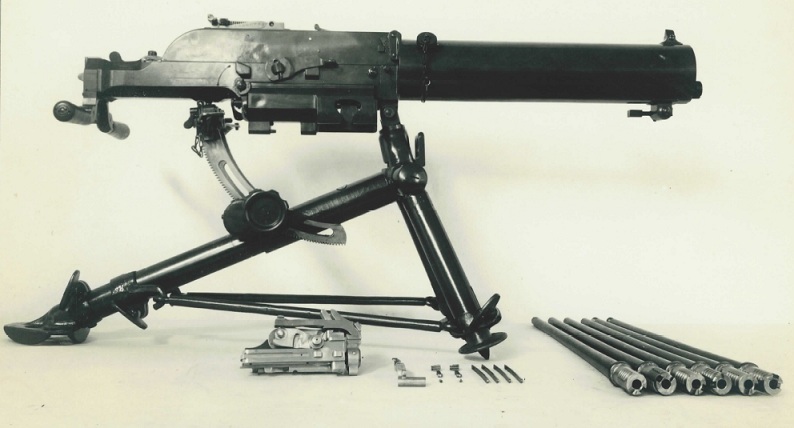
The Schwarzlose uses a toggle lock that looks at a glance similar to a Maxim or Luger lock, except that this toggle does not act to lock the bolt. Instead, the toggle must be broken and folded before the bolt can travel rearward, thus delaying it for a moment. This delay is long enough to allow chamber pressure to drop to a safe level (assuming everything is done right). This does require use of ammunition with a specific pressure curve, as overpressure ammunition will cause the bolt to open early and rupture cases while underpowered ammunition will simply fail to fully cycle the action. It also required an oil pump to lubricate cartridges to prevent extraction problems. The pump oil tank held a half liter of oil, which was good for about 4500 rounds of firing. In an effort to make the gun more portable, it was designed with a relatively short (20.75 inch / 525mm) barrel, to reduce weight of the barrel, jacket, and water. This meant that the gun had significant muzzle flash, hence the large flash suppressor.
 Schwarzlose machine gun mechanism
Schwarzlose machine gun mechanism
Along with those disadvantages, the gun did have some things working in its favor. Since the barrel did not move (like most contemporary recoil-operated actions), it was simpler to incorporate and seal the cooling water jacket. It also had a very sturdy and reliable feed system. In 1912, the design was modified to use a heavier bolt and spring (and slightly modified lever angle in the toggle), thus increasing the time before opening, which reduced the chamber pressure when it did open, which in turn allowed cartridges to reliably extract without being oiled. The most obvious visual distinction between the 1907 and 07/12 guns is the rounded hump on the from of the 1907 receiver, where the 1912 variation was square at the front of the receiver.
The gun loads from below and right of the receiver, and ejects empty cases out the lower right of the receiver. Loading the gun when empty requires inserting a belt and manually cycling the action three times while holding pressure on the loose end of the belt to bring the first cartridge into firing position. The feed mechanism consists of a gear-like wheel that holds the cartridges and rotates them up to the chamber and then down to the ejection port. Firing is done by depressing the central dual triggers between the gun’s handles. There is a safety located between the triggers, which must be held to the left by one thumb while firing.
History
The Schwarzlose was the standard heavy machine gun of the Austro-Hungarian army during World War 1, and was also adopted by the Czechoslovakian, Dutch, Serbian, Romanian, Bulgarian, Turkish, and Swedish armies. Italy captured a significant number of the guns, and used them both during and after WWI. Dutch and Czech Schwarzlose guns were chambered for 8×57 Mauser, while the Swedes used them in 6.5x55mm, and the standard Austrian chambering was 8x50R (later changed to 8x56R). Some guns were build in 6.5x54mm for Greece, but these were appropriated by the Austrian government when war broke out in 1914.
The Steyr company in Austria purchased the manufacturing rights for the gun in 1905, and built them until 1918. In 1931, Austrian guns were modified to use the new 8x56R cartridge, which provided a significantly higher muzzle velocity (2300fps, instead of about 1900-2000 with the 8x50R). This was done by rechambering the existing barrels. The British company Kynoch also built the Schwarzlose under license as the Kynoch Machine Gun. A number of other smaller-production variants were also made, including cavalry and aircraft guns.

Manuals
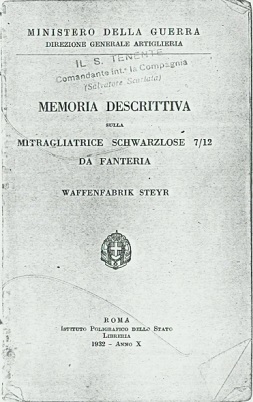
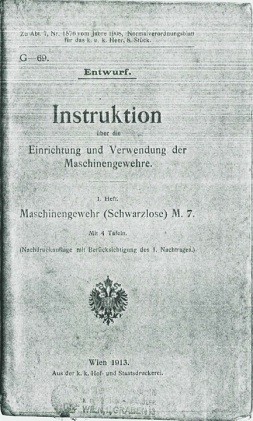
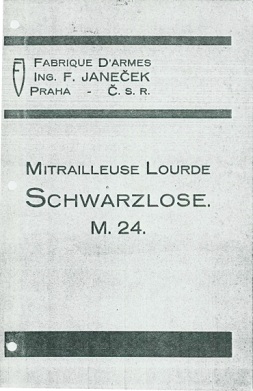

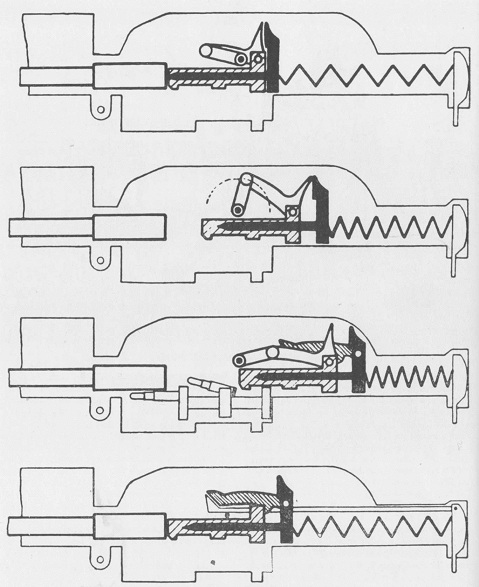 Schwarzlose machine gun mechanism
Schwarzlose machine gun mechanism
interesting information about this austro hungarian machine gun, looks like M/08 but is very diferent
The notion that the Schwarzlose must have a short barrel to function correctly and use ammo with lower pressures than standard military cartridges is false. The fact that the first cartridge used with this gun was the relatively slow 8X50R Mann round was merely circumstantial. The Czech VZ24 Schwarzlose used a 24″ barrel in 7.92 and functioned perfectly with standard 7.92 FMJ military ammo.
I have a number of these guns in the following calibers: 8X50R, 7.92 and 7.62X54R. All rounds function perfectly in the guns. The 54R gun will function with continuous metal SG43/PK belts and unmodified, standard 8X50R internals. The 7.92 07/12 has 24″ barrel and is an Austrian receiver assembled to the extended Austrian 07/12 jackets allegedly done by the Romanians. These 07/12s all had 7.92 Czech V24 internals, among other interesting oddities
Oiling, however, is required for extraction.
Bob Naess
Black River Militaria CIi
Great article!
Very interesting information, and thanks also to the commentators. My dad served on a Czech Vz.24 early on, as enlisted infantry. I’ve got a photo of him as an AG, prior to WW2.
One of these days I’ll find a kit and rebuild it as a semi…one of these days.
Great write up about a forgotten gun. What would one of these be worth today if it was still functional?
If it were registered and transferrable, I would guess probably $20k-$30k.
There’s a pretty good short summary of the Schwarzlose, its development history, it’s merits relative to contemporary rival designs ( eg, the Skoda MG )and it’s mechanical operation in Hogg’s “Machine Guns – 14th Century To Present” ( Krause Publications, 2002 ; Library Of Congress Catalog Number 2001091076 ; ISBN 0-87349-288-9 ) from pp.49-51. A detailed cutaway showing the operating mechanism is included on p.49, unfortunately without identification tags for the various components, so the reader will have to figure those out.
According to Hogg’s description, the M1907 had an oil tank capacity good for only 2000 rounds, and this was increased to 4500 rounds in the improved M1907/12. Also, the M1907’s cyclic rate of fire was 400 rds./min., and this was increased to 500 rds./min. in the M1907/12 and M1908/12 ( the latter two being designated according to year of adoption and end user ).
Speaking of really interesting forgotten weapons with real potential, pp.51-53 of the same book feature the almost unknown Friberg-Kjellman MG, along with some intriguing photographs and a condensed description and history. This MG used the now well-known system of locking flaps and weighed only 28 lbs ( 13 kg ) dry — a phenomenal weight reduction for water-cooled MG’s of the day — while still incorporating a 40-second QCB feature ( virtually unique to, and incredibly fast for, a water-cooled crew-served weapon ). It was also an extremely efficient and reliable MG, and all this should have made it a winner, but it fell victim to a combination of unfortunate circumstances that can best be summed up as “bad market and political timing”. The Swedish Government of the time might have adopted the gun based on the excellent Army trials results, but the decision to stay politically neutral meant that the same Government also saw little need for a new weapons system and all the expense it entailed, so the gun died a natural death before ever getting into production. Hogg states that only about a dozen examples were actually made, and that they appear to have been scrapped over time. That Hogg managed to include the Friberg-Kjellman MG in a volume that had to cover such a wide range of machine-guns and their development over a relatively long period in history is a tribute to both his and the book editor’s diligence.
Pretty cool,Google my last name and this came up.
On the question of barrel length on the Schwarzlose, is it not possible the original 1907 version did require the short barrel to avoid excessive pressure at the time the action began its opening cycle? My understanding of what Chinn vol. 1 says is that with the 07/12 the functioning cycle was revised, reducing the need for cartridge oiling. He does, however, say nothing as I recall about barrel length, tho I would wonder if the redesign wasn’t undertaken at least in part to provide a longer barrel and better ballistic performance. I write this being aware that the Austrian 07/12s retained the original barrel length, tho many of the contract guns did use a barrel of about 24 inches length.
Does the 945mm length include the flash surppressor or it is the length from the end of the receiver butt to the tip of the actual barrel?